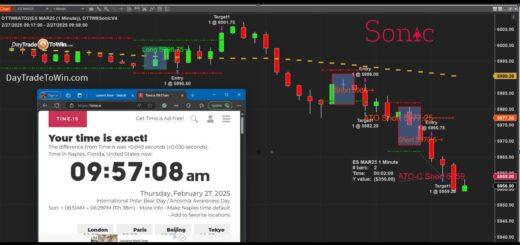A Day in the Life of a Sonic Trader: 5 Live Trades Analyzed
Hello Traders! Today is Monday, October 21st, and I’m excited to dive into the Sonic Trading System with you. I’ll be walking you through the first five trades of the day, showing the results in real-time to give you a clear picture of how the Sonic system performs in both winning and losing scenarios.
Trade #1: Kicking Off with a Win
The market opened at 9:30 AM New York time, and we quickly got our first signal to go long at 5950. I entered right at the target price, and within moments, the target was hit. This fast movement is typical at market open, where volatility tends to spike. While it’s tempting to jump in right away, especially with strong momentum, I always advise new traders to wait 5-10 minutes to let the initial volatility settle down.
Whether you’re trading the NASDAQ, crude oil, or gold, this rule applies. The open can be unpredictable, so patience is key. The first trade was a winner, using the default settings of the Sonic system.
Sonic Trading System Overview
The Sonic Trading System is unique in that it’s based on price action—no momentum indicators, moving averages, or Keltner channels here. The signals are generated purely by analyzing price patterns and trends. That dashed line you see on the chart? It’s a filter. If the price is above the line, we focus on long trades, and if it’s below, we switch to short trades. This filter is adjustable to suit your strategy.
Overtrading is a common issue, so we emphasize taking only the best setups. If a stop is too large or if the market conditions aren’t right, don’t force the trade. In our daily training sessions, we drill this into our traders.
Many traders combine Sonic with other systems like the Roadmap or Atlas Line. It can be a great addition to your day trading toolbox. Remember, if there’s a high-priority news event, it’s better to avoid trading. You can download our free news indicator on DayTradeToWin.com to stay on top of major events.
Trade #2: A Small Setback
The second trade was a signal at 5900. The setup looked good—target and stop at a 1:1 ratio. However, this one didn’t go in our favor. After entering, the market went against the position, and the trade was stopped out. That’s part of the game. No system wins 100% of the time, but the Sonic system aims for a balanced risk-to-reward ratio on every trade.
Adapting to Different Markets
One of the best features of the Sonic system is its adaptability. It works on any market: NASDAQ, Dow, currencies, you name it. That’s because it’s entirely based on price action, which is universal across markets.
For instance, during our third trade, we got a signal to go long at 5899.75. While some traders might enter immediately, I recommend aiming for a better price, even if it’s just a tick or two. A small improvement in entry can make a big difference, especially if the stop is a bit too far from the target.
Trade #3: A Strong Comeback
Our third trade hit the target with precision. The entry, stop, and target were well-balanced, and the market followed through nicely. Using a one-minute chart, we got a quick resolution to the trade—something you can expect if you prefer smaller time frames.
If you’re more of a long-term trader, you can still use Sonic with higher time frames like 5-minute or even tick charts. It’s highly versatile and gives traders control over how they want to trade.
ATR-Based Targets and Quick Profits
The Sonic system uses the Average True Range (ATR) to calculate profit targets. This means that the size of the target adapts to the volatility of the market. If the market is moving fast, the target will be larger. If it’s slower, the target shrinks, making it more likely to hit.
For quicker profits, you can even set the target to half of the ATR. This increases the chances of hitting the target sooner and getting out of the trade faster—a great approach if you don’t like holding positions for too long.
Trade #4: A Missed Opportunity
The fourth signal gave us an entry at 5927.5, but before I could place the order, the market had already gapped and hit the target. Sometimes, the market moves too fast, and there’s no reason to chase a trade. If it’s missed, it’s missed. Discipline is crucial in trading.
Trade #5: Closing Strong
The fifth and final trade of the day gave us another solid setup at 5991.25. I took my time analyzing the trade, considering the stop and target. Once again, the Sonic system delivered a balanced risk-to-reward ratio, and the target was hit almost immediately.
The key takeaway here is not to rush your trades. You always have control—analyze the setup, determine if the stop is manageable, and only enter if the trade makes sense for you.
Wrapping It Up
In just a few hours, I completed five trades using the Sonic Trading System. With three wins and one loss (plus one missed opportunity), the system performed as expected. The beauty of Sonic is its simplicity, focusing purely on price action with no reliance on complex indicators.
If you’re interested in adding the Sonic system to your trading arsenal, or want to learn more about our other systems like the Roadmap or Atlas Line, visit DayTradeToWin.com. You can also sign up for a free member account to access helpful tools like the news indicator and trial versions of our software.
Ready to take your trading to the next level? Join our accelerated mentorship program and get instant access to all our courses and software. Let’s trade the right way—by understanding price action.
Visit DayTradeToWin.com and sign up for your free account to access free trading tools and trials.




